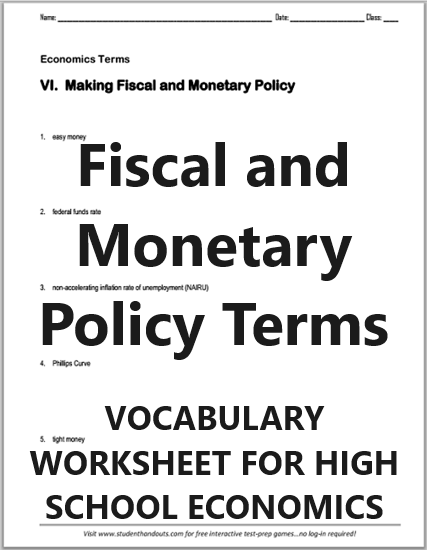| Fiscal and Monetary Policy Terms |
|---|
| www.studenthandouts.com > Social Studies > Economics > Fiscal and Monetary Policy |
 |
 |
|---|
|
Click here to print. Terms: easy money, federal funds rate, non-accelerating inflation rate of unemployment (NAIRU), Phillips Curve, tight money. Answers will vary. Easy Money: Easy money refers to a monetary policy stance where central banks set low interest rates and employ other measures to increase the money supply. This approach aims to stimulate economic growth by making borrowing cheaper and encouraging spending and investment. Easy money policies are typically used during periods of economic slowdown or recession to boost economic activity. In classroom discussion, ask students the pros and cons of this policy. Federal Funds Rate: The federal funds rate is the interest rate at which depository institutions lend reserve balances to other depository institutions overnight. It is a key monetary policy tool used by the Federal Reserve to influence overall economic activity, including levels of employment, inflation, and the economy's general health. Changes in the federal funds rate can impact interest rates across the broader economy. In classroom discussion, have students formulate their thoughts on the federal government's role in setting interest rates. Describe the changes in the federal interest rate in recent years, and how these fluctuations helped and hurt the economy. Non-Accelerating Inflation Rate of Unemployment (NAIRU): NAIRU represents the level of unemployment at which inflation does not accelerate. It reflects the balance between the demand for labor and the supply of labor in the economy. When unemployment falls below the NAIRU, inflation tends to rise, as employers increase wages to attract scarce workers, leading to higher prices. Conversely, when unemployment is above the NAIRU, inflationary pressures are generally subdued. This can be a complicated and confusing concept for students to grasp. Many students (possibly rightly so) are confuddled by how the capitalist economy of the United States relies on a certain percentage of the population being unemployed at all times. Phillips Curve: The Phillips Curve illustrates an inverse relationship between unemployment and inflation within an economy. According to this concept, lower unemployment rates correlate with higher inflation rates, while higher unemployment rates correlate with lower inflation rates. This relationship suggests a trade-off between inflation and unemployment in the short term, although the curve's stability and applicability have been debated. Have students collect data for recent years and ascertain for themselves how reliable the Phillips Curve actually is. Tight Money: Tight money refers to a monetary policy stance where central banks raise interest rates and restrict the money supply to curb inflation and slow down an overheating economy. This approach makes borrowing more expensive, reducing spending and investment. Tight money policies are typically employed to prevent or control inflation, stabilizing the economy and maintaining purchasing power. Researching U.S. monetary policy, students can determine for themselves how reliable this stance is. Does it occur in a vacuum, or are other factors at play? Lead students to articles in the business media describing the decisions made by major corporations during periods of low or high interest rates. Ask students, who decides that the economy is "overheating" and what standards are employed in reaching this conclusion? |
|---|
| www.studenthandouts.com > Social Studies > Economics > Fiscal and Monetary Policy |









